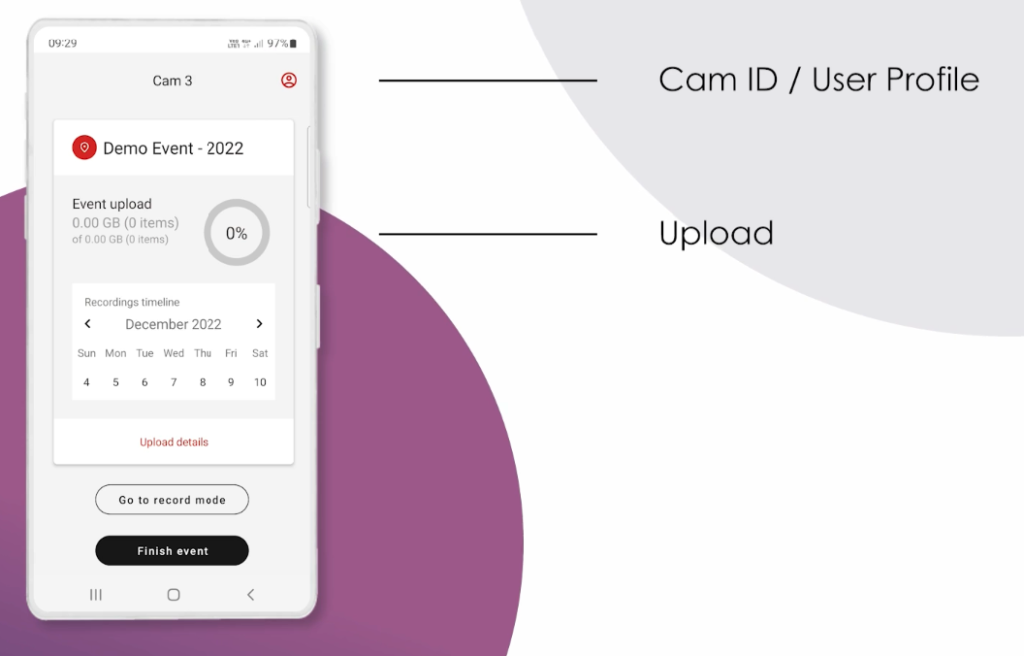Intro #
This tutorial is designed for you to understand how to record with the iRewind ONE App and how to operate the controls on the screen, so you know what settings you can adjust to get the best video results. The record mode used here is in Landscape, as this is the recommended orientation for recording. In case you are interested in Portrait Recording you can watch the separate tutorial “Record Portrait Mode”.
Record mode #
It’s finally event day, and you want to have the best possible footage of your event, of course! We got you covered! We’ll go into all the details that the Record Mode has to offer.

Tap on “Let’s Go” and well…let’s go!

This next screen shows you some useful information about the upload, Cam ID, and, on the top right, the User Profile. We covered these in our previous tutorial video, “Login screen & event details“.

What’s new here is that you have an indicator of the amount of footage uploaded out of the total footage recorded for the event in use. This proves especially handy when you quickly need to know how much footage you still need to upload on our servers before your videos can start to be rendered.
You’re also able to see the Dates on which you recorded footage for this event and access the Uploading details for the event. But we will share more info on the uploading process in our tutorial on Uploading & Finishing the Event.
Recording functions #
The app will take you to this next screen, which looks very similar to a regular smartphone recording screen, but a bit simplified. Let’s go now through these functionalities of the iRewind ONE APP record mode together.
First off is the Camera view.

You can see here the frame you want to record and also the Recording controls on the right side.
What you see at first glance is on the top left the “free memory space” you have left on your phone. And on the right side the ” white recording button”, which, if triggered, will “start or stop the recording”.
Recording controls #
Recording Control #
Once you hit that white recording button it turns red, which signals that it is in recording mode. You can also verify if it’s recording via the iRewind ONE Dashboard interface. More details about that can be found in the “iRewind One Dashboard Live Camera Acces” tutorial.
With the “x” on the top right, you go back to the event settings. Don’t worry, you can go back and forth during recording, or even minimize the app. The recording will continue.

Let’s quickly go into the other things you can adjust here in the record mode screen.
With the 3 dots button down here, several options will appear on the top of the screen
HDR Control #
The HDR button switches the HDR setting on or off.
We recommend enabling HDR only in low light, night conditions, or special light conditions, to improve the image quality. In the rest of the cases, we recommend having it off to get the best quality image.
Exposure (EV) Control #
With the EV button, you can manually set the exposure of the Video, if it seems too bright or dark for you. However, the device itself adjusts the quality so you will most likely only use it in special circumstances.
Auto-Focus (AF) Control #
With the AF button, you can turn “on” or “off” the Autofocus mode.
Please make sure it’s always set to AF and not crossed out and that the focus is correctly set.
This will allow the camera to always automatically adjust the focus to ensure optimum quality of the recorded footage.
To make things easy for you, all you need to do is:
Press and hold your finger on the part of the screen where you want it to be permanently focused. The message “Autofocus triggered” and then, “Autofocus locked” will appear on the screen. This is a very important step to do.
We will show you in more detail how the HDR, EV, and AF functionalities are used in a real life scenario during our Tutorial about “Camera Placement”
